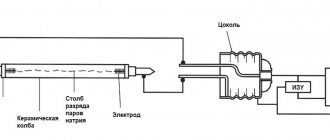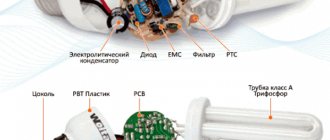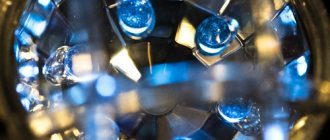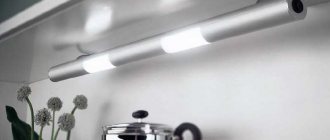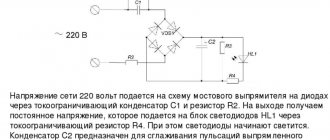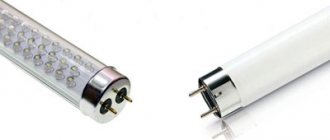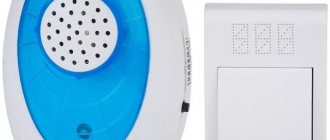Ten years ago, choosing the right light bulb was easier, because incandescent lamps were labeled with maximum power. Currently, new LED lamps are becoming increasingly popular. Choosing a product with the right wattage in the modern lighting era is more difficult, because LED lamps, compact fluorescent lamps and other energy-saving lamps have completely changed wattage values. Now focusing on watts will not be entirely correct, and it is not always possible. If in a regular store a specialist can still help you choose the right light bulb, then when making a purchase online, you are unlikely to find the watt in the description of this light bulb.
Calculating the luminous flux in a lamp is sometimes difficult
The relationship between lumens and watts
Why is it not enough to use the usual watts? Everything is simple here. Power itself, measured in watts, is a more general characteristic. Let's take a 100W incandescent lamp as an example. Of these, 70 W will be spent on heating the space, that is, a device with this amount of power operates in a range invisible to humans. But 30 W is the light that we see.
Next, let's take energy-saving lamps that have been improved in this regard. There, the ratio of work in the visible and invisible ranges is different - 95 to 5. If the device has a power of 32 watts, then in the visible range it will operate at 30 watts.
That is, a 100 W incandescent lamp gives us 30 W light. And a 100 W energy saving lamp is almost three times more. The same goes for LED products. Here is a comparison table that will show how powerful a lamp must be to produce a certain number of lumens.
| Luminous flux in lumens (lm) | Incandescent lamp power (W) | Fluorescent lamp power (W) | LED lamp power (W) |
| 400 | 20 | 5-7 | 2-3 |
| 700 | 60 | 15-16 | 8-10 |
| 900 | 75 | 18-20 | 10-12 |
| 1200 | 100 | 25-30 | 12-15 |
| 1800 | 150 | 40-50 | 18-20 |
From this table it can be seen that to obtain, for example, 700 lumens, we will need to purchase a 60-watt incandescent lamp, but an LED lamp with 8-10 watts is sufficient. And here it becomes clear why the same LED devices are much more economical, because when we consume electricity, we pay for watts.
Or a comparison in the other direction: a 20-watt incandescent lamp and a 20-watt LED lamp produce enormously different numbers of lumens: 400 Lm and 1800 Lm, respectively. At the same time, we take into account: the higher this indicator, the better the lighting and the closer the light is to natural. This means good color rendition, less strain on the eyes, etc.
Note that the table offers approximate, average indicators. They may differ depending on the design of the products, their manufacturing technology, etc. We recommend that you check the indicators for each individual lamp - if the lumens are not indicated on the packaging, just remember the ratio of the efficiency of incandescent lamps and LED devices.
Principle of operation
When connected to an electrical network, an incandescent lamp converts electrical energy into light by heating the filament. Made from refractory tungsten or its alloys, the filament is located in a glass flask filled with an inert gas or vacuum (for low-power lamps up to 25 W).
How the Ilyich light bulb works
The flask serves to protect against external factors, and the inert gas (krypton, nitrogen, xenon, argon and their mixtures) does not allow the tungsten conductor to oxidize and reduces heat loss. The thread heats up under the influence of the current passing through it to a temperature of about 3000ºC (such a high temperature over time leads to thinning and burnout of the conductor).
As a result of heating, electromagnetic radiation occurs, a small proportion of which is in the visible spectrum, the main part is infrared radiation. Luminous flux occurs when the very high temperature of the filament converts electromagnetic radiation into visible light from the lamp.
The energy consumed by the lamp is partially converted into radiation visible to the eye. The main part, under the influence of convection inside the flask, is dissipated in the process of thermal conduction.
The light produced by incandescent lamps lies in the yellow and red spectrum and is therefore close to daylight.
What is illumination and how to calculate its indicators?
Illumination is the level of luminous flux per 1 square meter. There is a separate value for this - lux (lx). That is, if one lumen of light falls on one square meter, this is equal to one lux: 1 lux = 1lm/m2.
Next, in order to calculate the required number of lumens per room, you need to know the sanitary standards developed for different rooms.
| Room type | Illumination standard |
| bathrooms (including bathtubs) in the apartment, as well as corridors, utility rooms | 50 lm/m2 |
| kitchen and living rooms: bedroom, living room | 150 lm/m2 |
| children's bedroom or playroom for a child | 200 lm/m2 |
| study, home office | 300 lm/m2 |
But you also need to take into account the height of the ceilings in the room. They don’t do this up to 2.7 meters, but then they add another factor.
| Room height (m.) | Additional coefficient for calculation |
| 2,7-3 | 1,2 |
| 3,1-3,5 | 1,5 |
| 3,5-4,5 | 2 |
Now we have all the data to calculate the minimum luminous flux. The formula looks like this:
Luminous flux (lm) = room area (m2) x standard illumination (lm/m2) x ceiling height factor (if any).
What is the luminous flux of LED and fluorescent lamps
Luminous flux (also luminous intensity) is a measure that characterizes the amount of luminous power in the emitted flux. It differs from electromagnetic radiation (including infrared, ultraviolet and visible light). Electromagnetic flux differs from light in that light is adjusted to reflect according to the sensitivity of the human eye to different wavelengths of light.
Luminous intensity (or luminous flux) is a common measurement parameter for low-power LEDs. Light intensity should be measured at a distance at which the model (device) can be considered a point source of light. The distance of the detector from the test sample required to meet this criterion is called the photometric distance. It depends on the dimensions of the light source being tested. The minimum coefficient, which is determined by the ratio of the distance to the detector and the maximum length of the light-emitting surface, can be from 5 to 15.
Many LEDs have a fairly large emitting area. Lenses, if present, can very quickly reveal the apparent position of the emitting center. The radiation measured at the detector is complexly related to the intensity of the source.
In this regard, the International Commission on Illumination (CIE) purposefully developed the concept of “intensity average LEDs” to solve a problem that most often occurs in near-field conditions. This is especially true for all LEDs, including —SMD LEDs—.
This concept has lost its relevance regarding the physically accurate determination of luminous intensity. However, to a greater extent, it refers to the measurement of illumination at a fixed distance and dimensions of the detector itself. The ultra-brightness diode is positioned such that its mechanical axis is directly in line with the center point of a circular detector with an active area of 1 cm square, and the surface of the detector should be perpendicular to this axis.
It happens that neither the luminous intensity nor the luminous flux provides the so-called “useful” light for a particular application. In this regard, something compromise is needed. The amount of partial LED flux was first introduced by the CIE. Luminous intensity includes flux and solid angle and is the ratio of these two values. This means that its unit is the candela. It is the product of a lumen and a steradian. Candelas indicate how bright the light is in a given direction.
The term luminous flux is also used to measure the visible light output of lamps when the light is not directed. It refers to visible light that is emitted in all directions at a given moment. In turn, the radiation flux is the total radiation (ultraviolet, visible and infrared) propagated from light in all directions.
LED partial lumen output also includes both flux and angle, but is expressed as flux within an angle rather than as a ratio. Thus, its unit of measurement is lumen with a specified angle (Lm). Like average LED luminous intensity, it is a measure of the near field and is similarly defined in terms of physical geometry rather than being a fundamental unit. This is why the term "LED" is included in the quantity. This distinguishes it from fragment flow, which can be calculated from far-field goniometric measurements.
Characterizing the luminous intensity distribution of LEDs and LED lighting sources is a purely photometric measurement task. It is carried out using a goniometer, which is used in conjunction with a spectroradiometer or photometer. The photometer allows you to make very fast measurements, literally “on the fly”. It is recommended to use it for purely photometric measurements. Spectroradiometers offer the clear advantage that all characteristics (radiometric, colorimetric and photometric) can be determined with maximum accuracy. However, goniospectroradiometers have a longer measurement time. These methods of measuring light flux are also typical for fluorescent ones.
When a lamp is new, its light output is at its maximum. As it is used, its performance and light output decreases. The term used to describe the reduction in luminous output is called luminous flux stability.
Luminous flux stability data is important for the construction industry, especially where it is necessary to maintain or design lighting levels in buildings. This allows you to schedule lamp replacements before light levels become too low. This is called routine maintenance and often involves cleaning the reflectors and lenses of the light fixture.
The lumen attenuation of HID lamps (fluorescent and HID) and LEDs is significantly higher than that of incandescent or tungsten lamps.
Here is an example of calculations
Let's say you have a children's room measuring 10 square meters and three meters high. In this case, we take the norm for children’s rooms - 200 lm/m2 and the coefficient for ceilings from 2.7 to 3 meters - 1.2.
We multiply these indicators: 10m2 x 200 lm/m2 x 1.2 = 2400 lm.
It turns out that for this nursery you need a luminous flux of 2400 lm. Based on this indicator, you can select the number and type of lamps by referring to our first table. This is a very convenient formula because it allows you to quickly and easily obtain indicators for each room.
Units
This is a physical quantity that, according to the international measurement system of units, is measured in Lx and Lm. As a rule, the second quantity is used for designation. The unit of light power does not depend on what color temperature the source is or the fact of how the light is produced. This can be an ice crystal with a filament or a gas-discharge square arc.
Basic light flux measurements
Are there any errors in the calculations?
Since we have already made allowances for the features of each individual lamp, it is fair to clarify that there will be errors in the calculations. The most accurate indicators of the required illumination can be obtained using a special device - a lux meter.
But the tables we provide allow us to achieve a minimum level of error - it will definitely not affect either comfort or health. If it is not possible to use professional calculations, you can calculate everything yourself and choose the optimal solution.
70627
Date of publication: 05/03/2018
Advantages and disadvantages of energy-saving lamps
Improved energy consumption is an undoubted advantage of fluorescent and LED lighting sources. However, several disadvantages of their use can be identified.
The main disadvantage is, of course, the high cost of these products. Their price is on average 10 times higher than the price of a standard lamp. But this disadvantage is compensated by their durability. Typically, fluorescent lamps last about 8 times longer, and LED lamps last 15 times or more. The durability of energy-saving light sources is highly dependent on voltage drops in the power circuit. If changes occur frequently, the durability of the products is reduced.
As a disadvantage, one can highlight the linear emission spectrum of such lamps. This means that it does not emit light in a continuous range of frequencies, but in the short, most intense parts of the range. That is, objects illuminated by such lamps will not accurately convey their color. This leads to the eyes getting tired faster when working. Replacing conventional lamps with economy lamps when working with increased visual intensity is not recommended.
Fluorescent fixtures can sometimes emit ultraviolet radiation, which increases as the product ages. Ultraviolet radiation is dangerous for skin and polymer parts exposed to radiation.
In addition to energy efficiency, several other advantages of such lamps stand out. They compensate well for the shortcomings:
- Emitting light over a large surface area;
- Durability without frequent switching on;
- Absence or slight heating of the case during operation;
- Possibility to choose a comfortable color temperature.
Table “Light output of different types of lamps”
Lamp type | Light output, lm/W |
| Standard incandescent lamp | 7-17 |
| Kryptonian | 8-19 |
| Halogen | 14-30 |
| Mercury | 40-60 |
| Luminescent | 40-90 |
| Compact fluorescent | 40-90 |
| Sodium | 90-150 |
Luminous efficiency means that per 1 W of power the lamp produces a certain number of lumens of light. Based on the data in the table “Light efficiency of different types of lamps”, an energy-saving compact fluorescent lamp will be four to nine times more economical than an incandescent lamp. A standard 60 W lamp produces approximately 600 lumens, while a compact lamp has the same value with a power of 10 - 11 W.
Heat dissipation
The heat dissipation of a lighting device is a negative and harmful characteristic for lighting lamps. The higher the temperature of the device during its operation, the more energy it wastes on unnecessary heating. Moreover, excessive temperature of the lamp can lead to burns (if the lamp is accidentally touched) or to fire and damage to finishing materials (for example, a plastic or suspended ceiling may melt). In this parameter, incandescent lamps are noticeably inferior to LED lamps; they heat up very much and spend a large amount of energy on heating. This is certainly due to the operating principle of this lighting device.
Application in everyday life
Light sources of this type are widely used in everyday life. The table of luminous flux of fluorescent lamps and LEDs illustrates this. Application possibilities range from home lighting to illumination of nightclubs and discos. This includes room lighting, lighting for specialized workplaces, ultraviolet disinfection, decoration, and automotive lighting. Energy-saving lamps are an alternative light source that is recommended to be used, despite the high cost. In any case, it pays off and benefits the person.
Useful tips Connection diagrams Principles of operation of devices Main concepts Meters from Energomer Precautions Incandescent lamps Video instructions for the master Testing with a multimeter
Calculation of payback when replacing lamps with LEDs
Let's compare a 10 W LED bulb for 200 rubles and a 15 W LL for 150 rubles. Based on the minimum service life of the latter (50 thousand hours), you will have to buy 7 pieces of luminescent products, the total cost is 1050 rubles.
If the lighting device is lit for 5 hours a day, the LL spends 0.3 kW, LEDs - 0.2 kW. For a month you get 9 and 6 kW, in rubles at a tariff of 4 rubles per kilowatt - 36 and 24 rubles, for a year - 432 and 288 rubles. At first glance, the difference is small.
This is a calculation for one light bulb, and in any apartment there are several lamps that differ in power. If you carry out the calculation for each, the result will be more impressive.
When calculating, it is also necessary to take into account replacement costs. The highest costs are when completely replacing lamps. You can save money if you buy LED products of similar sizes with the same base.
If we take into account the most important parameter - light output, the advantage of LEDs is even more obvious, because an LED source with the same number of lumens as an LL illuminates the space better.
Main conclusions
After comparison, the advantage of LED lamps is obvious. The high cost of LEDs is compensated by their long service life and improved lighting quality.
Advantages of LED sources:
- environmental friendliness;
- resistance to voltage fluctuations;
- low ripple factor;
- no noise.
All this is only true if high-quality products are used for replacement. Although it should be noted that the LED lamp is not of the highest quality, it improves the optical performance of lighting due to the absence of noise and low pulsation coefficient.
Types of lamp bases
In domestic conditions, lamps with three types of bases are used: small, medium and large, or, in technical terms, E14, E27 and E40. The numbers in the name indicate the diameter of the base in millimeters. The most common base size is E27. The E14 base is often called “mignon” (translated from French as “small”). The E40 socket is used for street lighting lamps with a power of 300, 500 and 1000 W.
In addition to bases that are screwed into the socket using a thread, there are types of pin-type lamp bases. They are called G-sockets. Their main types are G5, G9, 2G10, 2G11, G23 and R7s-7. G-bases are used in compact fluorescent and halogen lamps to save space. Using two or four pins, the lamp is attached to the lamp socket.
Incandescent lamp power
One of the most important characteristics of a lamp is the power of incandescent lamps. It is always indicated by the manufacturer on the cylinder or base, and the luminous flux that comes from the lamp and is calculated in lumens depends on it. Do not confuse the light output of a lamp with the level of light it emits: an energy-saving lamp with a power of 5 W will shine no worse than a 60 W incandescent lamp. As a rule, data on light output is not recorded anywhere, so when choosing a lamp you need to rely on the advice of sellers or use the data in the table “Light efficiency of different types of lamps”.
